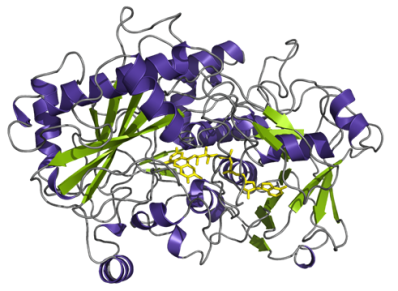Evolution and engineering of pyranose dehydrogenase for biofuel cell applications
SUPERVISOR: DIETMAR HALTRICH
Project assigned to: CHRISTOPH GONAUS
Background.
Enzymatic fuel cells transform chemical to electrical energy at least partially due to enzymatic catalysis of electrochemical reactions and usually operate under moderate conditions (20 - 40°C). Therefore they are suitable where high temperatures and other extreme conditions are undesirable, whereas achievable current and power densities are approaching the range of applicability of micro-scale electronic applications. Pyranose dehydrogenase (PDH) is an interesting candidate for catalyzing the anode reaction because it has high affinity for glucose as substrate while also featuring a very broad sugar substrate specificity allowing the use of e.g. sucrose or lignocellulose hydrolysates as substrate. Furthermore it is capable of oxidizing more than one C-atom, enabling higher electron yield and coloumbic efficiency. Unlike the commonly used glucose oxidase, electrons are not transferred to oxygen and therefore no H2O2 is being produced which would damage the enzyme and reduce biofuel cell life span. These properties make pyranose dehydrogenase an attractive target for optimization (Sygmund, 2011; Tasca 2007)
Aims and methods.
In this project site-saturation mutagenesis and directed evolution will be employed for improving catalytic activity with selected electron acceptors, enzyme activity at low temperatures, biocatalyst stability and electron yield. Mutazime I and taq-Polymerase will be used to create mutant libraries which will be in vivo assembled or shuffled in Saccharomyces cerevisiae (Zumarraga, 2008). Expressed mutants will be screened with photometric high throughput assays.
Electrochemical studies with selected promising mutants will be conducted in close cooperation with Prof. Dr. Lo Gorton (Lund University, Lund, Sweden) and structural studies with Dr. Christina Divne (Karolinska Institute, Stockholm, Sweden). Once attractive pyranose dehydrogenase variants are established a stay at both partners is planned to conduct characterization. Additionally to improving pyranose dehydrogenase for use in biofuel cells also increasing our knowledge on structure/function relationships of PDH is an aim of this work.

Sygmund C, Gutmann A, Krondorfer I, Kujawa M, Glieder A, Pscheidt B, Haltrich D, Peterbauer C, Kittl R (2011) Simple and efficient expression of Agaricus meleagris pyranose dehydrogenase in Pichia pastoris. Applied Microbiology and Biotechnology, pp. 1-10, in press.
Tasca F, Timur S, Ludwig R, Haltrich D, Volc J, Anntiochia R, Gorton L (2007) Amperometric biosensors for dedection of sugars based on the electrical wiring of different pyranose oxidases and pyranose dehydrogenases with osmium redox polymer on graphite electrodes. Electroanal, 19, 294-302.
Zumarraga M, Camarero S, Shleev S, Martinez-Arias A, Ballesteros A, Plou FJ, Alcalde M (2008) Altering the laccase functionality by in vivo assembly of mutant libraries with different mutational spectra. Proteins 71, 250-260.
